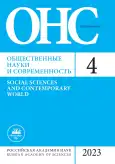Gender gap in the federal government authorities under conditions of the rising economic role of women in modern Russia
- Authors: Brushkova L.A.1
-
Affiliations:
- Financial University under the Government of the Russian Federation
- Issue: No 4 (2023)
- Pages: 123-134
- Section: Articles
- URL: https://journals.rcsi.science/0869-0499/article/view/249431
- DOI: https://doi.org/10.31857/S086904992304007X
- EDN: https://elibrary.ru/OXWUCO
- ID: 249431
Cite item
Full Text
Abstract
About the authors
Lyudmila A. Brushkova
Financial University under the Government of the Russian Federation
Email: lbrushkova@yandex.ru
Moscow, Russia
References
- Женщины и мужчины России (2020) Статистический сборник. М.: Росстат. 239 с.
- Кочкина Е.В. (1999) Представленность женщин в российских органах власти // Общественные науки и современность. № 1. С. 173-183.
- Поленина С.В. (1990) Участие женщин в государственной и общественной жизни // В: С. В. Поленина, А. А. Абрамова, А. А. Азарова и др. Труд, семья и быт советской женщины. Отв. ред. С. В. Поленина. М.: Юридическая литература. 430 с.
- Силласте Г.Г. (2019) Социальные транзиции и формирование нового гендерного порядка // Женщина в российском обществе. № 2. С. 9-12.
- Силласте Г.Г. (2019) Страновой гендерный ландшафт как фактор формирования нового гендерного порядка, его социальные риски // Женщина в российском обществе. № 3. С. 4-13.
- Хасбулатова О.А., Смирнова И.Н. (2021) Женское движение в России: моделирование баланса взаимодействия государства и женской инициативы // Женщина в российском обществе. № 1. С. 3-9.
- Connell R.W. (1987) Gender and Power: Society, the Person and Sexual Politics. Cambridge: Polity. 316 p.
Supplementary files









